Bonnet disassembly (again!) (24 – 26 May 2003)
I completed the body filling on the front section of the bonnet, and so it was time to take the various pieces apart once again. You might recall that we inserted thin cardboard strips between the sections before bondoing (more details here 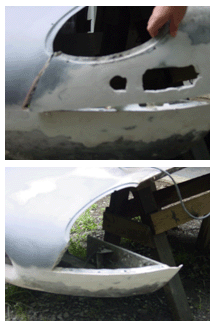 near the bottom of the page). Now that we needed to take it all apart again, it was just a matter of removing the hardware and tapping the pieces with a rubber mallet. The two wings came off with a little tiny tap, and the lower section dropped from the center section without so much as a wiggle or twist. The parts look good. (The pictures to the right are small because the originals were very fuzzy. Making them smaller at least shows the gross results a little more clearly. Next time, I’ll look at the picture on the camera before continuing!)
near the bottom of the page). Now that we needed to take it all apart again, it was just a matter of removing the hardware and tapping the pieces with a rubber mallet. The two wings came off with a little tiny tap, and the lower section dropped from the center section without so much as a wiggle or twist. The parts look good. (The pictures to the right are small because the originals were very fuzzy. Making them smaller at least shows the gross results a little more clearly. Next time, I’ll look at the picture on the camera before continuing!)
Once the various sections were apart, we could move them around more easily, making it easier to smooth the parts that were harder to access, such as the bottom of the lower bonnet section and the inside parts of the bonnet mouth.
One thing we ran into that sapped several hours was bad behavior of a “sandable” primer made by Rustoleum. We applied some sandable primer over well cured “regular” primer (also a Rustoleum product), and the sandable primer formed cracks before our eyes as it dried. We were dumb enough to try twice, thinking we hadn’t prepped the primer surface, but the same cracking occurred. Then we gave up, and the bad Rustoleum primer went on the shelf. I’m thinking it would work fine on clean metal, but over primer it will not do.
We wanted to use the sandable primer to take out some of the irregularities still hiding on the nose of the bonnet. We’ll do the best we can without it at this point, and pay special attention to the area when we use the “Tie-Coat” primer over the POR-15. It, too, is sandable.
We focused effort on the bonnet’s center section and the lower section. We were able to get the front of the center section in good shape and prepared for POR-15. The “mouth” section of the bonnet still requires a bit more work, especially since the left and right sides of the center section don’t seem quite symmetrical. One thing about working on the mouth with disassembled pieces: it is easier to get at areas and to compare the two sides of a part from different angles. That ability alone has speeded the process.
The plan now is to complete the little metal work (mainly grinding) that is left on a few of the tabs of the bonnet, reassemble the pieces using cardboard along the top seam between the two wings and the center section, and then smooth that seam as we did the others in front. The next time we disassemble should be the last (except, of course, for some adjustment as will probably be required). After this “cardboard” treatment, the bonnet will be ready for final smoothing and application of POR-15. Then reassembly with adhesives and all the parts!
A little chrome buffing (17 – 18 May 2003)
Since it was raining, a little inside work was in order. I took out the buffer and grabbed the left front bumper. The chrome was obscured by lots of dirt and what may have been oxidized chrome. But after some quick buffing with cleaning grits the old luster came out. The plating looks pretty good from a few feet, but at close range you can see how thin the plating is in some areas. Although the chrome isn’t blistered or grossly pitted, there are very small, almost pore-like, holes in the plate. These are visible only up close.
The bumpers are good enough that replating them would be a waste of money, and I’m hoping that a high-gloss clear coat will obscure the small imperfections. Even without the coating, the bumpers wil be fine from a few feet distant, and that’s good enough. The clear coat is another POR-15 product. I’ll be applying it to all polished metal areas of the car.
Rainy eyeball repairs
The weekend was rainy, on and off, so the bonnet was frequently hidden beneath plastic sheeting to protect the bare metal from the elements. I did do some repair to the right headlight area of the bonnet, though. In our enthusiasm to remove the dents, we were a bit overzealous, and we banged out a “dent” that was actually supposed to be there. On the side of the headlight hole that is toward the center of the bonnet, there is a crease that extends from the back of the bonnet to a point nearly two-thirds of the way down the headlight hole toward the front of the car. We flattened a good portion of that crease, and we discovered the asymmetry by running our hands on each side of the bonnet.
Fortunately, the left headlight area is in very good shape, untouched by collision damage. It provided the details of the correct shape, and a few pictures on the web really helped (notably some of the closeups in the “workshop” area of Classic Jaguar’s site).
That small repair pretty much characterizes what lies ahead for us on the bonnet. It’s a matter of getting the details as right as we can. It is this kind of work that makes the body repair so slow and tedious, but this kind of work is also something that can’t be hurried along or ignored. The details are exceptionally visible.
So, a weekend means repair of a little part of a headlight. Scary to think how many hours might go by working on this important part of the car!
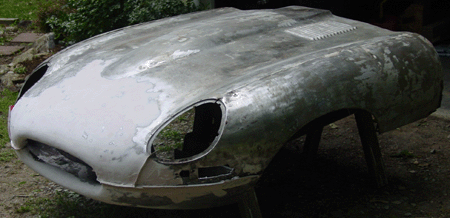 and would require more than a smattering of body filler to bring it out to the point it needed to be. I estimated that we’d need to apply about a quarter inch of Bondo to about a five-inch stretch of the lower lip, roughly from the center toward the right side.
and would require more than a smattering of body filler to bring it out to the point it needed to be. I estimated that we’d need to apply about a quarter inch of Bondo to about a five-inch stretch of the lower lip, roughly from the center toward the right side.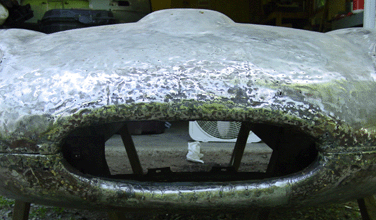 But we have not achieved what’s needed. The metal itself is now sound, though we do have a few gaps to repair. The severe corrosion on the nose has been removed and reinforced, either by cutting out the offending section and replacing it with new metal (as on the left wing and the lower “lip” of the mouth) or by removing rust and reinforcing with an inside plate of metal (as with the upper “lip” of the mouth and a few small sections on the lower part of the bonnet assembly).
But we have not achieved what’s needed. The metal itself is now sound, though we do have a few gaps to repair. The severe corrosion on the nose has been removed and reinforced, either by cutting out the offending section and replacing it with new metal (as on the left wing and the lower “lip” of the mouth) or by removing rust and reinforcing with an inside plate of metal (as with the upper “lip” of the mouth and a few small sections on the lower part of the bonnet assembly).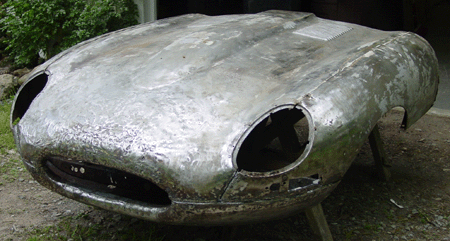 it became very apparent what needed to be pulled and pounded.
it became very apparent what needed to be pulled and pounded.
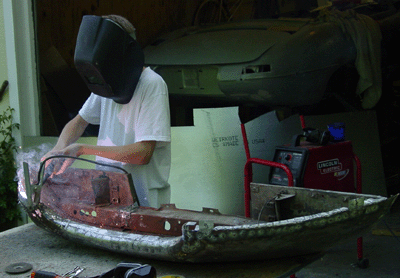 set of tabs that connect the lower section to the two wing sections and the upper center section. Also the mouth section itself had received the same treatment as the upper half — welded tabs, curled, and smeared with Bondo. Lots of Bondo. It seems I grossly overestimate the amount of such work that we can accomplish in a full weekend, since I was thinking these repairs would be a day or so. And then we’d go forth and assemble the bonnet in its rough form just to take a look. But it took the whole weekend to get the metalwork done on the lower section.
set of tabs that connect the lower section to the two wing sections and the upper center section. Also the mouth section itself had received the same treatment as the upper half — welded tabs, curled, and smeared with Bondo. Lots of Bondo. It seems I grossly overestimate the amount of such work that we can accomplish in a full weekend, since I was thinking these repairs would be a day or so. And then we’d go forth and assemble the bonnet in its rough form just to take a look. But it took the whole weekend to get the metalwork done on the lower section.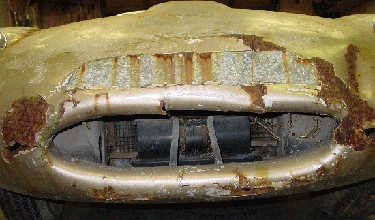 I have to admit that I didn’t know what to expect when we finally stripped it and began to work on it. When I first looked at the car in the rain at the side of a Virginia corn field, I wondered if indeed the bonnet was already too far gone to be repaired. It looked a mess, with the nose all punched in and the artless, careless bandaid treatment with HVAC sheet metal riveted and Bondo-pasted to the front. Aside from the punched in nose, there were a few places of rust at the rear portion of the wings. But other than those obvious troublesome places, the bonnet appeared intact and exhibited only “surface rust.”
I have to admit that I didn’t know what to expect when we finally stripped it and began to work on it. When I first looked at the car in the rain at the side of a Virginia corn field, I wondered if indeed the bonnet was already too far gone to be repaired. It looked a mess, with the nose all punched in and the artless, careless bandaid treatment with HVAC sheet metal riveted and Bondo-pasted to the front. Aside from the punched in nose, there were a few places of rust at the rear portion of the wings. But other than those obvious troublesome places, the bonnet appeared intact and exhibited only “surface rust.” the body when we removed the paint, and I suspect that the person applying that ancient layer of Bondo was too lazy to remove the paint. It is likely that the bonnet had been disassembled at one time and the center section replaced with a used section from a green car.
the body when we removed the paint, and I suspect that the person applying that ancient layer of Bondo was too lazy to remove the paint. It is likely that the bonnet had been disassembled at one time and the center section replaced with a used section from a green car.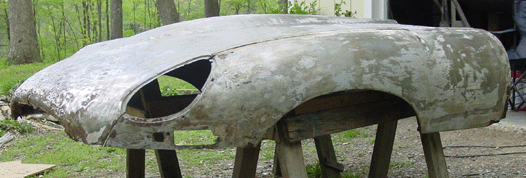 had weakened the bumper attachment points. No upper bolts required the cutting blade; a couple along the lower tabs needed that treatment. (I have been surprised at how few bolts we’ve had to cut off — which either speaks to the power of penetrating fluids or the hardware that Jaguar chose.)
had weakened the bumper attachment points. No upper bolts required the cutting blade; a couple along the lower tabs needed that treatment. (I have been surprised at how few bolts we’ve had to cut off — which either speaks to the power of penetrating fluids or the hardware that Jaguar chose.)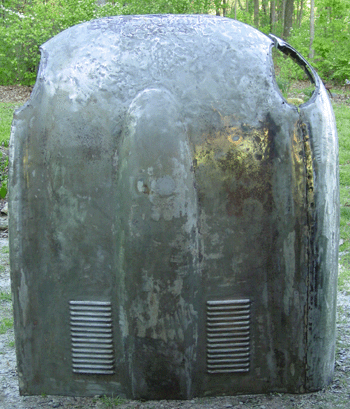 wing. This was a little tricky, since we found that reinforcing that tab changed some of the bending chracteristics of the whole piece. Basically, it bowed a little, so that the tab at the top of the wing didn’t fit flush against the center section. We had to apply pressure to bring the sections together snugly. In order to correct this difficulty, we pounded the attached metal a bit, so that the new metal would stretch against the tab. This helped, though it did not entirely correct the bow. The sections do fit together well now, and they are ready for finer mending after we complete the repair of the other wing and the lower bonnet section (the lower part of the mouth).
wing. This was a little tricky, since we found that reinforcing that tab changed some of the bending chracteristics of the whole piece. Basically, it bowed a little, so that the tab at the top of the wing didn’t fit flush against the center section. We had to apply pressure to bring the sections together snugly. In order to correct this difficulty, we pounded the attached metal a bit, so that the new metal would stretch against the tab. This helped, though it did not entirely correct the bow. The sections do fit together well now, and they are ready for finer mending after we complete the repair of the other wing and the lower bonnet section (the lower part of the mouth).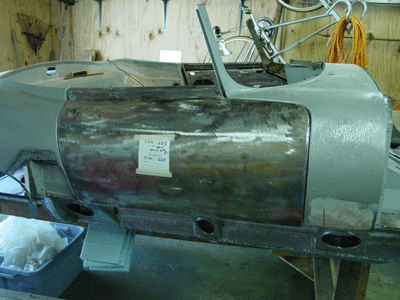 process: 1. Remove the window crank and the door latch handle by pushing the escutcheon away from the handle and pushing the lock pin through the hole. Remove the door panel 2. Remove the lower door hole access plates by drilling out the pop rivets that hold them in place. Scrape off the rubbery weather seal with a knife. 3. Remove the hardware attaching the chrome window rails from the top section of the door and from the two tabs inside the panel assembly at the bottom of the door. 4. Slide the window rails out through the top of the door carefully. 5. Remove the bolts and screws that affix the latch mechanism and the window crank mechanism to the door panel assembly. 6. Carefully pull the window glass through the top of the door and, after the glass is completely free, remove the window crank mechanism. You will have to adjust the crank mechanism to pull the glass free without binding the mechanism in the door panel assembly. 7. Remove the bolts that hold the exterior door latch handle. This is done inside the door panel. Then unclip the door latch mechanism from the inside of the latch handle. 8. Remove the handle from the outside of the door and then the latch assembly through the access holes in the door panel assembly. (You can remove the anti-drum material any time you can get a hold of it.)
process: 1. Remove the window crank and the door latch handle by pushing the escutcheon away from the handle and pushing the lock pin through the hole. Remove the door panel 2. Remove the lower door hole access plates by drilling out the pop rivets that hold them in place. Scrape off the rubbery weather seal with a knife. 3. Remove the hardware attaching the chrome window rails from the top section of the door and from the two tabs inside the panel assembly at the bottom of the door. 4. Slide the window rails out through the top of the door carefully. 5. Remove the bolts and screws that affix the latch mechanism and the window crank mechanism to the door panel assembly. 6. Carefully pull the window glass through the top of the door and, after the glass is completely free, remove the window crank mechanism. You will have to adjust the crank mechanism to pull the glass free without binding the mechanism in the door panel assembly. 7. Remove the bolts that hold the exterior door latch handle. This is done inside the door panel. Then unclip the door latch mechanism from the inside of the latch handle. 8. Remove the handle from the outside of the door and then the latch assembly through the access holes in the door panel assembly. (You can remove the anti-drum material any time you can get a hold of it.)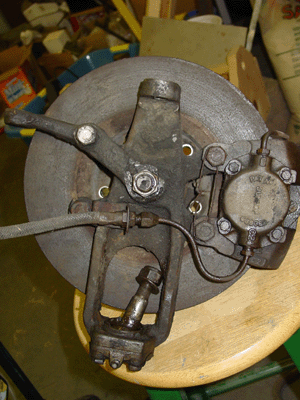 the wheel bearings. We were able to get much of the assembly apart, but I decided to bring the tough-to-disassemble parts into a local British automobile dealership and service shop. They had the tools and the experience with the items to take them apart completely, and I didn’t have to puzzle over it.
the wheel bearings. We were able to get much of the assembly apart, but I decided to bring the tough-to-disassemble parts into a local British automobile dealership and service shop. They had the tools and the experience with the items to take them apart completely, and I didn’t have to puzzle over it.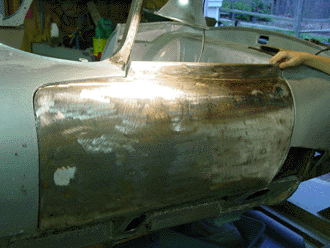 itself. The “skin” of the left door looks quite good. The lower section where the internal box-like door body attaches to the external metal sheet was a little rusted, with a few small corrosion holes poking through. But the metal resisted pressure all right, and we will go ahead and repair the corrosion from the inside of the door. I suspect that the doors corrode in that section because of the weird way that moisture is handled. Water that spills from the body on top of the door falls through a small drain hole, and that drain hole spills into a rubber hose that diverts the water around the internal section of the door hinge attachment inside the door panel. But the strange thing to me was that the hose simply dumps water into the door panel. I would have thought that the hose would have diverted the water all the way through the door to an external hole. As it was originally designed, the water flows into the door panel and then out through two slits on the bottom of the door. The effect is that water can easily collect inside the door panel, and may even be retained by the anti-drum material fitted inside of the door. This material looks like a rubberized felt, but it seems to be still somewhat absorbent. I will probably just replace the hose as I found it, but I have thought that maybe I should alter the door a bit to give the water flowing in a more direct way out. The interior of the door panel will at least be well rust-proofed, so the next generation can renew the door skins if they need to.
itself. The “skin” of the left door looks quite good. The lower section where the internal box-like door body attaches to the external metal sheet was a little rusted, with a few small corrosion holes poking through. But the metal resisted pressure all right, and we will go ahead and repair the corrosion from the inside of the door. I suspect that the doors corrode in that section because of the weird way that moisture is handled. Water that spills from the body on top of the door falls through a small drain hole, and that drain hole spills into a rubber hose that diverts the water around the internal section of the door hinge attachment inside the door panel. But the strange thing to me was that the hose simply dumps water into the door panel. I would have thought that the hose would have diverted the water all the way through the door to an external hole. As it was originally designed, the water flows into the door panel and then out through two slits on the bottom of the door. The effect is that water can easily collect inside the door panel, and may even be retained by the anti-drum material fitted inside of the door. This material looks like a rubberized felt, but it seems to be still somewhat absorbent. I will probably just replace the hose as I found it, but I have thought that maybe I should alter the door a bit to give the water flowing in a more direct way out. The interior of the door panel will at least be well rust-proofed, so the next generation can renew the door skins if they need to.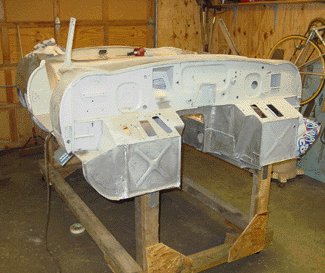 building such a fancy rotating mount for the car. I suppose it would be nice, but we’ll flip this car over as need be. That said, I did need to create something to make it easier to move the body out of the way when we weren’t going to be working on it. I used lumber we had saved from an old chicken coop and four middle duty casters from the lumber yard to build a rolling rack. It stands about two feet high, and it carries the car quite high — perhaps a little too high. But it’ll do. And it was really nice to be able to roll the car body to the side to sweep the floor and clean up. It’ll practically be necessary once we need to move larger parts (like the bonnet) out of the garage to work on. The fact that it’s fairly high is also a nice feature, since I won’t have to be bending down all of the time to work on areas in the interior.
building such a fancy rotating mount for the car. I suppose it would be nice, but we’ll flip this car over as need be. That said, I did need to create something to make it easier to move the body out of the way when we weren’t going to be working on it. I used lumber we had saved from an old chicken coop and four middle duty casters from the lumber yard to build a rolling rack. It stands about two feet high, and it carries the car quite high — perhaps a little too high. But it’ll do. And it was really nice to be able to roll the car body to the side to sweep the floor and clean up. It’ll practically be necessary once we need to move larger parts (like the bonnet) out of the garage to work on. The fact that it’s fairly high is also a nice feature, since I won’t have to be bending down all of the time to work on areas in the interior.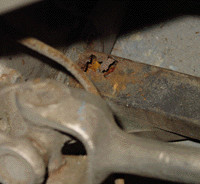 spanning the gap between the two side frames) was rusted through on the bottom. And a section below the battery area, on the underside of the tube, was rusted clear through. This damage wasn’t apparent from the top of the vehicle, though when everything was flipped over it was very easy to see.
spanning the gap between the two side frames) was rusted through on the bottom. And a section below the battery area, on the underside of the tube, was rusted clear through. This damage wasn’t apparent from the top of the vehicle, though when everything was flipped over it was very easy to see.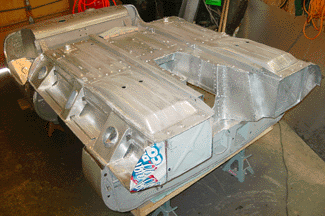 showed up to help flip the car back to “normal-side-up.” The day before, I had finished up with POR-15-ing the left floor panel and setting the rear floor stiffener to rights. I was anxious to get the car back to normal (at least in orientation). This wasn’t a tremendously productive weekend, but it did have that milestone.
showed up to help flip the car back to “normal-side-up.” The day before, I had finished up with POR-15-ing the left floor panel and setting the rear floor stiffener to rights. I was anxious to get the car back to normal (at least in orientation). This wasn’t a tremendously productive weekend, but it did have that milestone.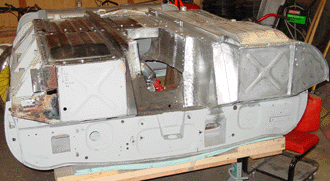 welding, and Aaron did the welding, for the most part. As I said in the
welding, and Aaron did the welding, for the most part. As I said in the 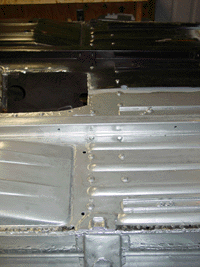 of the panel (along the seam of floor panel and outer sill) had a very natural fit. We basically just laid the panel on the car and welded. However, the central portion of the panel (behind the cross member where the right and left floor panels meet) seemed to bulge a bit. We will bolt that area in any case, and probably weld it as well. As I recall, the original floor panels had a separate panel attached in this area, which is the part that forms the “floor” of the drive shaft tunnel. I don’t know that this original panel was an original part, in any case. (I haven’t look at the notes or at the parts themselves, but this piece may actually have been something other than metal.) The pictures I have seen of this area don’t show a metal cover over the area. And yet, a sheet covering the area where the floor panels meet actually doesn’t sound like a bad idea.
of the panel (along the seam of floor panel and outer sill) had a very natural fit. We basically just laid the panel on the car and welded. However, the central portion of the panel (behind the cross member where the right and left floor panels meet) seemed to bulge a bit. We will bolt that area in any case, and probably weld it as well. As I recall, the original floor panels had a separate panel attached in this area, which is the part that forms the “floor” of the drive shaft tunnel. I don’t know that this original panel was an original part, in any case. (I haven’t look at the notes or at the parts themselves, but this piece may actually have been something other than metal.) The pictures I have seen of this area don’t show a metal cover over the area. And yet, a sheet covering the area where the floor panels meet actually doesn’t sound like a bad idea.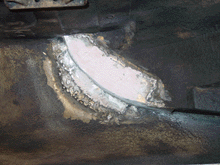 interior meets the lower edge of the convertible top. This area has been badly corroded, and crudely “fixed” with Bondo and wood strips (!). We had removed this blodged repair, and intended on doing some metal work. That we did, with two pieces of 20-gauge metal. The first piece was aligned with the curve of the upper portion of the left rear quarter panel, and the second piece (welded on top of the first piece from inside the wheel well) formed the fillet wall. As with other fixes, we ground off the welding excesses, and used Bondo to smooth the surface. We were actually less worried about how this fix looked, since it is in a place where you really need to want to look to see it at all. After the application of Rock Guard to the area, this fix won’t be easily visible. But trained eyes will see it, I guess. If they look for it….
interior meets the lower edge of the convertible top. This area has been badly corroded, and crudely “fixed” with Bondo and wood strips (!). We had removed this blodged repair, and intended on doing some metal work. That we did, with two pieces of 20-gauge metal. The first piece was aligned with the curve of the upper portion of the left rear quarter panel, and the second piece (welded on top of the first piece from inside the wheel well) formed the fillet wall. As with other fixes, we ground off the welding excesses, and used Bondo to smooth the surface. We were actually less worried about how this fix looked, since it is in a place where you really need to want to look to see it at all. After the application of Rock Guard to the area, this fix won’t be easily visible. But trained eyes will see it, I guess. If they look for it….